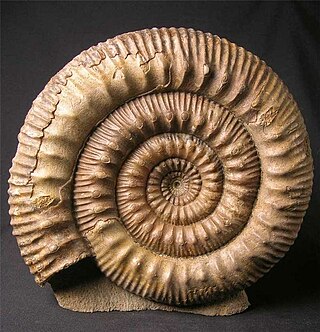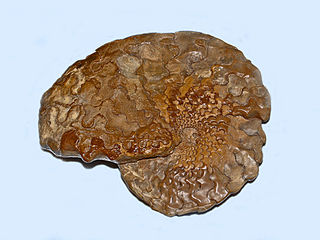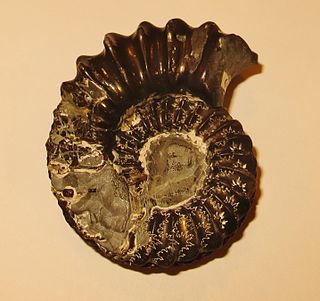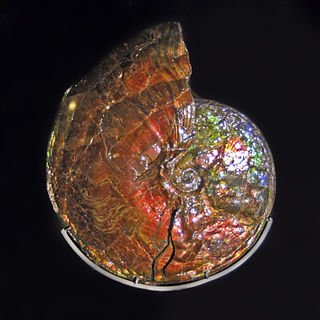
Stephanoceras is an extinct genus of Stephanoceratoid ammonite which lived during the Bajocian. It is the type genus of the family Stephanoceratidae.

Audaxlytoceras is an extinct genus of lytoceratid ammonites.

Arcticoceras is an extinct ammonoid cephalopod genus from the late Middle Jurassic belonging to the ammonite family Cardioceratidae, more commonly found to high northern latitudes.
Frechiella is an ammonite with a smooth, somewhat globose involute shell that lived during the later part of the Early Jurassic, which has been found in England and Italy. The shell is coiled so that the outer whorls cover most of the inner, leaving the inner whorls only slightly exposed. The outer rim, known as the venter, is broadly arched, with either a low narrow keel bordered by small grooves, or a large median groove.

Ceratitida is an order that contains almost all ammonoid cephalopod genera from the Triassic as well as ancestral forms from the Upper Permian, the exception being the phylloceratids which gave rise to the great diversity of post-Triassic ammonites.

Ammonitina comprises a diverse suborder of ammonite cephalopods that lived during the Jurassic and Cretaceous periods of the Mesozoic Era. They are excellent index fossils, and it is often possible to link the rock layer in which they are found to specific geological time periods.
Euaptetoceras is an evolute hildoceratoid ammonite from the lower Middle Jurassic, included in the family Hammatoceratidae and the subfamility Hammatoceratinae. The genus may be a junior synonym for Eudmetoceras of Buckman, 1920.
Newmarracarroceras is an ammonite from the early middle Jurassic with a ribbed subinvolute shell with a keel running along the venter, or outer rim. The umbilicus is moderately wide, exposing the inner whorls exposed in part.
Haplopleuroceras is a Middle Jurassic ammonite and likely member of the Hildoceratacean family Sonniniidae with which it shares the same sort of ribbing.

Tissotiidae is a family of ammonites (Ammonitina) belonging to the Acanthoceratoidea.
Subcollina is a genus of evolute to serpenticonic stephanoceratacean ammonites from the Middle Jurassic (Baj) of Mexico, placed in the family Spiroceratidae.

Macrocephalites is a genus of the stephanoceratoid ammonite family Macrocephalitidae, diagnostic of the Callovian stage of the Middle Jurassic. Three subgenera, Dolikephalites, Kamptokephalites, and Pleurocephalites are recognized in addition to Macrocephalites itself, with Indocephalites tentatively included as the fourth.

Kepplerites is a moderately evolute ammonite from the lower Callovian included in the Stephanoceratoidea.

Hecticoceras is an ammonite genus belonging to the haploceratoid family Oppeliidae, that lived during the Middle and Late Jurassic, from the Callovian. Hecticoceras may be seen as a series of some nine subgenera, beginning with the lower Callovian H. (Hecticoceras) and H. (Hecticoceratoides) and ending with the lower Oxfordian H. (Pseudobrightia) and H. (Eochetoceras). Hecticocerassensu lato and Prohecticoceras from the underlying Bathonian form the oppeliid subfamily, Hecticoceratinae.

Placenticeratidae is an extinct family of mostly Late Cretaceous ammonites included in the superfamily Hoplitoidea, derived from the Engonoceratidae by an increase in suture complexity.
Megalytoceras is an extinct genus of ammonite from the middle Jurassic, belonging to the suborder Lytoceratina.

Hauericeras is an ammonite genus from the Late Cretaceous that lived from the Coniacian to the late Maastrichtian, from about 90 to 66 mya. Fossils have been found in Europe, Russia, South Africa, Australia, India, Iraq, and in the United States.
Megalytoceratinae is a subfamily of lytoceratids ammonites consisting of planulate forms, i.e. those with moderately evolute compressed shells with bluntly rounded venters, in which the outer whorls become smooth and sutures tend to resemble those of the Perisphinctidae. The family includes three genera, Megalytoceras, and Metrolytoceras, from the Middle Bajocian of England, Perilytoceras from the Toarcian and a fourth possible member, Asapholytoceras, from the Toacian of southeastern Europe.
Sonniniidae is a diverse family of Middle Jurassic ammonites ranging from those with stout evolute shells to those whose shells are sharply rimmed, oxyconic. The keel, which runs along the middle of the venter, is typically hollow. Sutures vary from simple to complex. The aptychus is shiny with coarse folds (Cornaptychus).
Ochetoceras is a genus of ammonites, belonging to the Oppeliidae, that lived during the Late Jurassic from the early Oxfordian to the early Tithonian, and type for the subfamily Ochetoceratinae.










